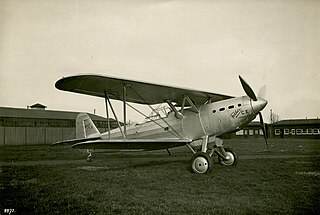
The Fokker C.X was a Dutch biplane scout and light bomber designed in 1933. It had a crew of two.

Fokker D.XVII, was a 1930s Dutch sesquiplane developed by Fokker. It was the last fabric-covered biplane fighter they developed in a lineage that extended back to the First World War Fokker D.VII.

The PZL.38 Wilk (wolf) (PZL-38) was a Polish heavy fighter developed and manufactured by PZL state factory in 1937. Intended for use primarily as a fighter-bomber, the Polish Air Force also envisioned it replacing light fighters in long-range operations, along with being able to serve as a light bomber. Only two examples were built before the project was cancelled in favor of a planned improved variant, the PZL.48 Lampart.

The Douglas C-1 was a cargo/transport aircraft produced by the Douglas Aircraft Corporation for the United States Army Air Service starting in 1925.
The Arado SD I was a fighter biplane, developed in Germany in the 1920s. It was intended to equip the clandestine air force that Germany was assembling at Lipetsk. The layout owed something to designer Walter Rethel's time with Fokker. Of conventional configuration, the SD I featured a welded steel tube frame, metal-covered ahead of the cockpit, and fabric-covered aft of it. The wooden sesquiplane wings were braced with N-type interplane struts, without any wires - a typical Fokker feature.

The Praga BH-111 was a sportsplane of Czechoslovakia, designed and built specifically to compete in Challenge 1932, the European touring plane championships. It was a two-seater low-wing monoplane.

The Fokker D.II was a German fighter biplane of World War I. It was a single-seat fighter aircraft developed before the Fokker D.I. It was based on the M.17 prototype, with single-bay unstaggered wings and a larger fuselage and shorter span than production D.IIs. Using a 75 kW (100 hp) Oberursel U.I, the D.II was underpowered, though the single 7.92 mm (.312 in) lMG 08 machine gun was normal for 1916. The German Army purchased 177.

The Caproni Ca.101 was a three-engine Italian airliner which later saw military use as a transport and bomber. It was designed in 1927 and first flown in 1928.
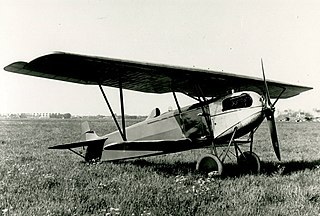
The Fokker D.XI was a 1920s Dutch single-seat fighter designed and built by Fokker

The Fokker F.XXXVI was a 1930s Dutch four-engined 32-passenger airliner designed and built by Fokker. It was the largest transport designed and built by Fokker. Only one was built, and it was used for some commercial routes starting in 1935, and later aviation training by the British Royal Air Force until 1940.

The Fokker C.VIII was a reconnaissance aircraft built in the Netherlands in the late 1920s. Intended primarily for the photographic reconnaissance role, it was a larger machine than other Fokker reconnaissance types of the period, with space for a third crew member, who acted as camera operator. It was also Fokker's first aircraft of this type to be built as a monoplane, a parasol wing configuration. The construction, however, was in the familiar Fokker style with wooden wings covered with plywood and fabric, and a steel-tube fuselage, also fabric-covered.
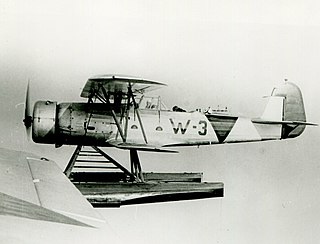
The Fokker C.XI-W was a reconnaissance seaplane designed to operate from warships that was produced in the Netherlands in the mid-1930s. It was the result of a Royal Netherlands Navy specification of 1935 requesting such an aircraft. Fokker's response was a conventional single-bay biplane with staggered wings of unequal span braced by N-struts. The pilot and observer sat in tandem, open cockpits, and the undercarriage consisted of twin pontoons. The wings were of wooden construction with plywood and fabric covering, and the fuselage was of steel tube, also covered with fabric.

The Fokker DC.I was an aircraft produced in the Netherlands in the early 1920s to fulfill a role of combined fighter and reconnaissance aircraft. The company designation chosen by Fokker, "DC" reflected this, with "D" being the Idflieg designation for a fighter during World War I, and "C" being an armed reconnaissance aircraft. The DC.I was a conventional single-bay biplane with staggered, unequal-span wings braced by N-struts and was derived from the Fokker C.IV design. The pilot and observer sat in tandem, open cockpits, and the undercarriage was of fixed, tailskid configuration, with the main units linked by a cross-axle. The wings were of wooden construction, and the fuselage was of welded steel tube covered in fabric.

The PWS-21 was a Polish passenger aircraft for 4 passengers, built in PWS factory in 1930, that remained a prototype.

The Heinkel HD 37 was a fighter aircraft, designed in Germany in the late 1920s, but produced in the USSR for Soviet Air Force service. It was a compact, single-bay biplane with staggered wings of unequal span, braced by N-type interplane struts. The pilot sat in an open cockpit, and the main units of the tailskid undercarriage were linked by a cross-axle.

The Heinkel HD 39 was a special-purpose cargo aircraft developed in Germany in the 1920s to distribute the Berlin newspaper B.Z.. It was a conventional single-bay biplane with staggered wings of equal span, and a fuselage that nearly filled the interplane gap. The pilot sat in an open cockpit, and the undercarriage was of fixed, tailskid type with divided main units. The sole example of the type was built after Ernst Heinkel found out, by chance, that B.Z. required such an aircraft and had ordered two machines from Albatros. Heinkel convinced publisher Ullstein-Verlag to purchase a third aircraft from his firm.
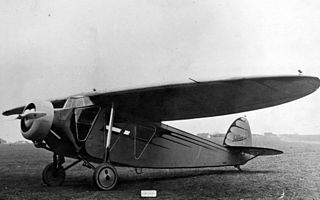
The Lublin R-XI was the Polish passenger plane for 4 passengers, designed in 1930 in the Plage i Laśkiewicz factory in Lublin, that remained a prototype.
The Junkers J 21 was a reconnaissance aircraft designed in Germany in the early 1920s and produced in the Soviet Union at the Junkers plant at Fili for use by the Soviet Air Force.
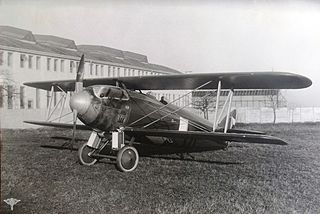
The Letov Š-20 was a fighter aircraft produced in Czechoslovakia during the 1920s.

The Fokker PW-5 was a Dutch fighter aircraft of the 1920s. It was a parasol monoplane of which twelve were built for the US Army Air Service, being used as advanced trainers.



















